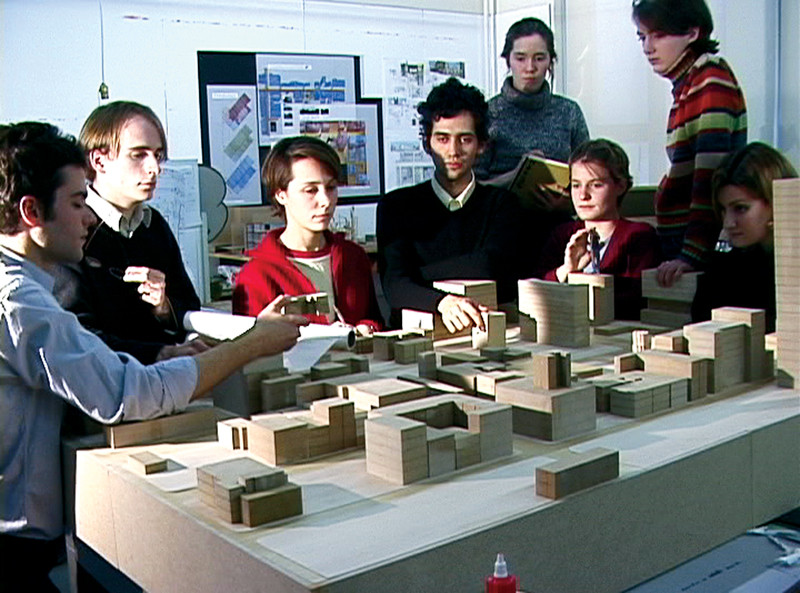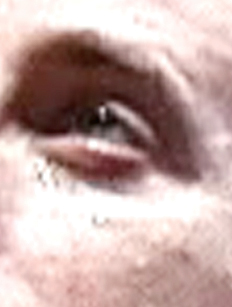[Spring 2005]
Recalling a history of negotiated relationships between the static and moving image, these revelations of movement cause us to scan his still images for discreet signs of motion and life.
by Will Straw
Adad Hannah’s Stills are described on the artist’s Web site as “real time video projected tableaux vivants.”1 The three couplets within that description each evoke distinct histories and complexes of artistic concerns.
“Real time” designates the best-known feature of Hannah’s video work – its recording of frozen, posed situations. The time-based character of the images – the fact that they are not stills, but video sequences of several minutes’ duration – is betrayed in minor bits of movement. The projection of these works underscores their place within a century-long interrogation of the cinematic image and its relationship to time and change. And reference to the tableau vivant suggests that Hannah is interested in performative practices of posing and gesture on their own terms. In this interest, we recognize Hannah’s commitment to the broader contemporary enterprise through which the cinema is restored to its place within a longer history of visual experiments and illusions.
In a longstanding paradox of the cinematic image, the temporal continuum of Hannah’s images is apparent only when their continuity is interrupted by minor instances of change (as when a body lists slightly to one side or another.) Before these interruptions, the relationships of the image to time are multiple, like the different tenses through which “pastness” is expressed in written or spoken language. Are the shots of human beings contemplating gallery paintings (in Tribute or Guided, both 2002) typical cases chosen to represent innumerable acts of viewing, exemplary instances of a more limited sample, or specific, localized situations important because of their singularity? Once our eye catches the signs of movement, we move quickly from the first to the third of these readings. These changes reconfigure our attention as viewers, rendering us suspicious and vigilant. The leisurely exploration of space quickly terminates, replaced by an attentiveness to the possibility of further movement. This movement – typically undramatic in scope and highly localized within the space of the image – now offers itself as the meaning of the image. Conscious of its probable repetition, we begin to distinguish between foreground and background, between the elements within the image that are capable of movement and those that are not. As our prejudices come to guide us, we scan the fragile limbs and awkward postures of the human beings within these images. (It is there that we expect to catch movement.) Movement has already signalled to us the limited temporal boundaries of the work as a whole, and we strain to catch every minor instance of change before the piece runs out.
Movement does to stasis, in these works, what recorded sound did to moving images in films of the late 1920s. The shot in the silent film was characterized by a hazy sense of duration, with no obvious rationale for its conclusion; images (of character or situation) were presented as typical or recurring almost as often as they stood for the momentary “present” of narrative time. With recorded sound and dialogue, the visual became more tightly bound to the unfolding of a calibrated, sequential time. (It was the relationship of sound to image, arguably, rather than the interplay of visual points of view, that “sutured” spectators into a naturalized sequence of acts and images.) The tiny bits of movement in Hannah’s Stills have the same effect. They do not simply interrupt or diminish temporal indeterminacy. With the first glimpse of movement, indeterminacy is eliminated, and the intervals between movements become acutely felt units of duration.
In either direction, the passage between stasis and movement may serve to reveal technological inefficiency or failure. The breakdown of film in a projector transforms movement into a series of stills straining to pass through the apparatus before they catch fire. The nervous jumps of a videotape that is imperfectly paused suggest the frustration of a still image struggling to start moving again.
Moves to unsettle the boundaries between stasis and movement are scattered throughout the history of audiovisual media. They may be found both in experimental interrogations of a medium’s ontology and as gimmicks within popular forms. Tom Gunning has noted that early film projections by the Frères Lumière would begin with a still image that began to move, thus offering a literal instantiation of the projector’s capacity to animate the world.2 (The 1941 Hollywood comedy film Hellazoppin’ would repeat this gesture to comic effect.) Seven decades after the Lumières, cinematic modernism expressed itself in the concluding freeze-frames with which films like Bonnie and Clyde acknowledged the crisis of narrative and their inability to achieve closure within narrative time itself. Between these two historical moments, popular cinema came to disavow any connection between the technological initiation of movement and the beginnings of narrative. Narrative got underway only after a series of ceremonial gestures (musical fanfares, studio logos, credit sequences), which came to seem more crucial in bringing representation to life than the technologically based passage of still images through a projector.
Experimental cinema has given us works in which stills seek to convey movement (Chris Marker’s La Jetée) and others, equally canonical, in which moving images invite the sustained contemplation more typical of the still (Michael Snow’s Wavelength). At the other edge of mainstream popular cinema, in the horror film, bits of movement within apparently still images will signal the presence of menace – as the eyes in painted portraits begin to move, or when the apparently dead bodies of monsters begin to twitch. The revelation of life in Hannah’s stills is rarely so unsettling, and there is no Frankenstinian sense of the horrific being awakened. Life is revealed, nevertheless, in the movement of natural forces against the backdrop of solid structures: in the blinking of eyes (Crying, 2002) or in the brief gusts of wind that cause a ribbon to fluctuate (Hole, 2002). These works tie in with a history of popular entertainments through the ways in which such movements stand as betrayals, as if each Still struggles to survive against natural forces or human weaknesses that ultimately defeat it, puncturing its temporal indeterminacy and requiring the artist to start again.
2 Tom Gunning, “An Aesthetic of Astonishment: Early Film and the (In) Credulous Spectator,” in Linda Williams (ed.), Viewing Positions:
Ways of Seeing Film (New Brunswick, N. J.: Rutgers University Press, 1995), p. 118.
Born in New York, Adad Hannah is currently a PhD candidate at Concordia University in Montreal. A recovering performance artist, he works mostly with video and photography. His Stills videos have been presented at Loop 04 International Video Art Fair (Barcelona), Youth Biennial Bucharest (2004), SeNef Festival/11min Art Museum (Seoul 2004), Big M, Mediakunst Tour (Groningen, Amsterdam, and Nijmegen 2004), and Artists Space (New York 2003). In Canada he has recently shown at Alternator, B-312, Dazibao, MSVU, Optica, SAW, Séquence, and TPW. In September he will première a new piece at Le Mois de la Photo.
http://adadhannah.com
Will Straw is an associate professor of communications within the Department of Art History and Communications Studies at McGill University. He is the author of numerous articles on cinema, music, Canadian culture, and media.
Many thanks to Johanne Sloan for input and discussion.
























